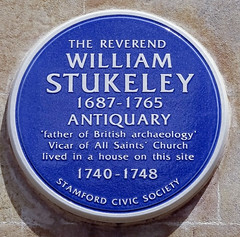William Stukeley
Commemorated on 3 plaques
The Reverend William Stukeley 1687-1765 Antiquary 'father of British archaeology' Vicar of All Saints' Church lived in a house on this site 1740-1748
Barn Hill, Stamford, United Kingdom where they lived (1740-1748)
William Stukeley, the noted 18th century antiquary lived in the house opposite, No 9, 1743-48. The structure above was part of the house forming a bridge that spanned the road. It formed Stukeley's study and library. Stukeley claimed that King Charles I spent the last night of freedom in this house, May 1646.
Barn Hill, Stamford, United Kingdom where they lived near
Rev Dr William Stukeley 1687-1765 pioneer antiquarian lived in a house near this site 1726-1730 accurately recorded Stonehenge and Avebury prehistoric monuments, wrote memoirs of Sir Isaac Newton
72 Castlegate, Grantham, United Kingdom where they lived



.jpg?width=250)
